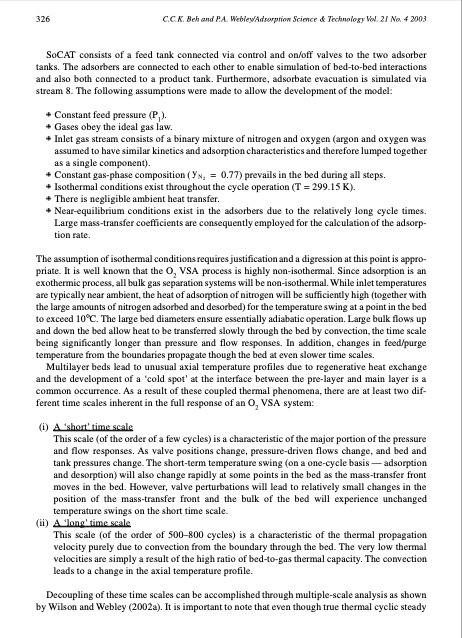
PDF Publication Title:
Text from PDF Page: 008
326 C.C.K. Beh and P.A. Webley/Adsorption Science & Technology Vol. 21 No. 4 2003 SoCAT consists of a feed tank connected via control and on/off valves to the two adsorber tanks. The adsorbers are connected to each other to enable simulation of bed-to-bed interactions and also both connected to a product tank. Furthermore, adsorbate evacuation is simulated via stream 8. The following assumptions were made to allow the development of the model: Constant feed pressure (P1). Gases obey the ideal gas law. Inlet gas stream consists of a binary mixture of nitrogen and oxygen (argon and oxygen was assumed to have similar kinetics and adsorption characteristics and therefore lumped together as a single component). Constant gas-phase composition ( yN2 = 0.77) prevails in the bed during all steps. Isothermal conditions exist throughout the cycle operation (T = 299.15 K). There is negligible ambient heat transfer. Near-equilibrium conditions exist in the adsorbers due to the relatively long cycle times. Large mass-transfer coefficients are consequently employed for the calculation of the adsorp- tion rate. The assumption of isothermal conditions requires justification and a digression at this point is appro- priate. It is well known that the O2 VSA process is highly non-isothermal. Since adsorption is an exothermic process, all bulk gas separation systems will be non-isothermal. While inlet temperatures are typically near ambient, the heat of adsorption of nitrogen will be sufficiently high (together with the large amounts of nitrogen adsorbed and desorbed) for the temperature swing at a point in the bed to exceed 10 C. The large bed diameters ensure essentially adiabatic operation. Large bulk flows up and down the bed allow heat to be transferred slowly through the bed by convection, the time scale being significantly longer than pressure and flow responses. In addition, changes in feed/purge temperature from the boundaries propagate though the bed at even slower time scales. Multilayer beds lead to unusual axial temperature profiles due to regenerative heat exchange and the development of a ‘cold spot’ at the interface between the pre-layer and main layer is a common occurrence. As a result of these coupled thermal phenomena, there are at least two dif- ferent time scales inherent in the full response of an O2 VSA system: (i) A ‘short’ time scale This scale (of the order of a few cycles) is a characteristic of the major portion of the pressure and flow responses. As valve positions change, pressure-driven flows change, and bed and tank pressures change. The short-term temperature swing (on a one-cycle basis — adsorption and desorption) will also change rapidly at some points in the bed as the mass-transfer front moves in the bed. However, valve perturbations will lead to relatively small changes in the position of the mass-transfer front and the bulk of the bed will experience unchanged temperature swings on the short time scale. (ii) A ‘long’ time scale This scale (of the order of 500–800 cycles) is a characteristic of the thermal propagation velocity purely due to convection from the boundary through the bed. The very low thermal velocities are simply a result of the high ratio of bed-to-gas thermal capacity. The convection leads to a change in the axial temperature profile. Decoupling of these time scales can be accomplished through multiple-scale analysis as shown by Wilson and Webley (2002a). It is important to note that even though true thermal cyclic steadyPDF Image | Dynamic Response and Characteristics of an Oxygen Vacuum Swing Adsorption

PDF Search Title:
Dynamic Response and Characteristics of an Oxygen Vacuum Swing AdsorptionOriginal File Name Searched:
026361703322405051.pdfDIY PDF Search: Google It | Yahoo | Bing
CO2 Organic Rankine Cycle Experimenter Platform The supercritical CO2 phase change system is both a heat pump and organic rankine cycle which can be used for those purposes and as a supercritical extractor for advanced subcritical and supercritical extraction technology. Uses include producing nanoparticles, precious metal CO2 extraction, lithium battery recycling, and other applications... More Info
Heat Pumps CO2 ORC Heat Pump System Platform More Info
| CONTACT TEL: 608-238-6001 Email: greg@infinityturbine.com | RSS | AMP |